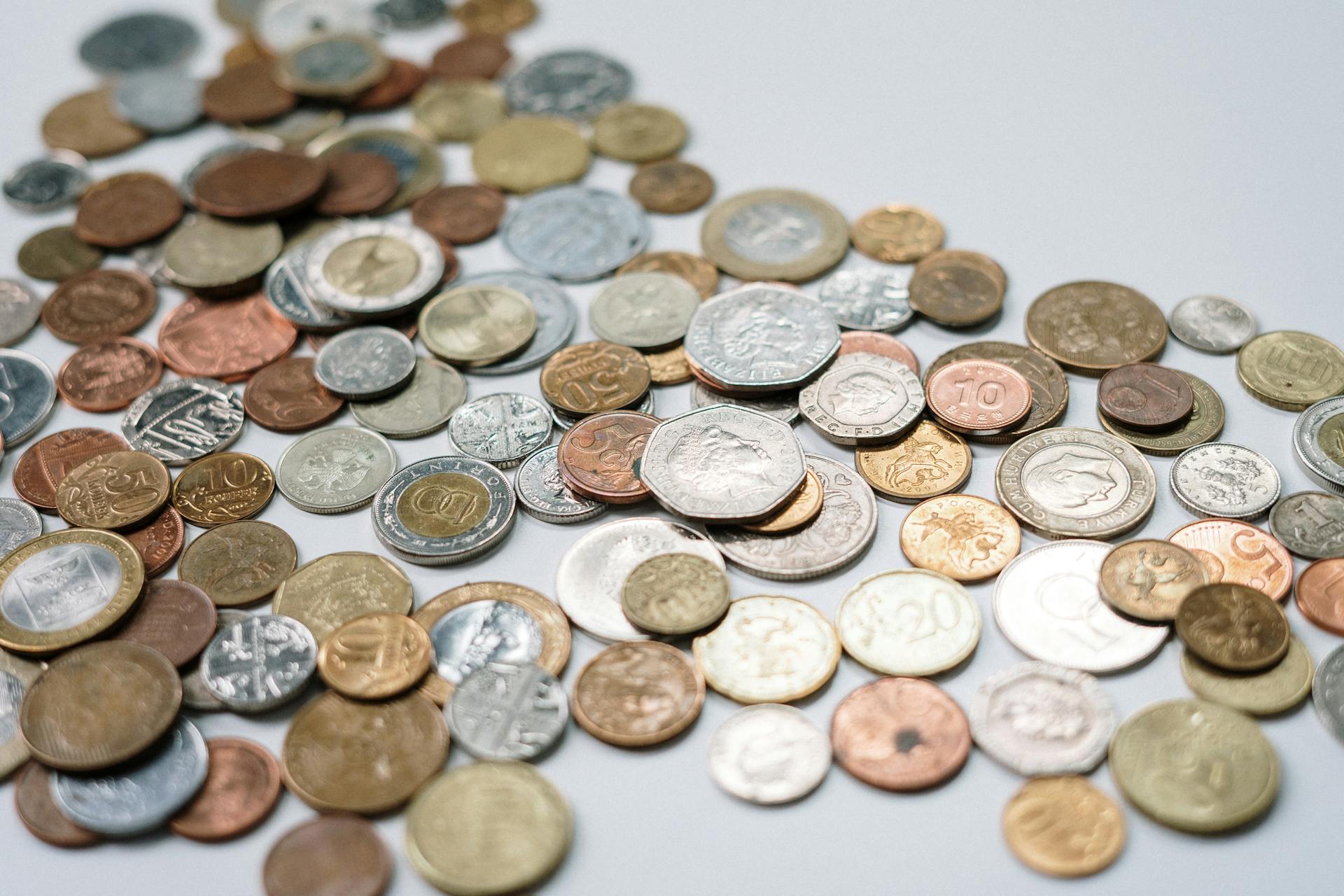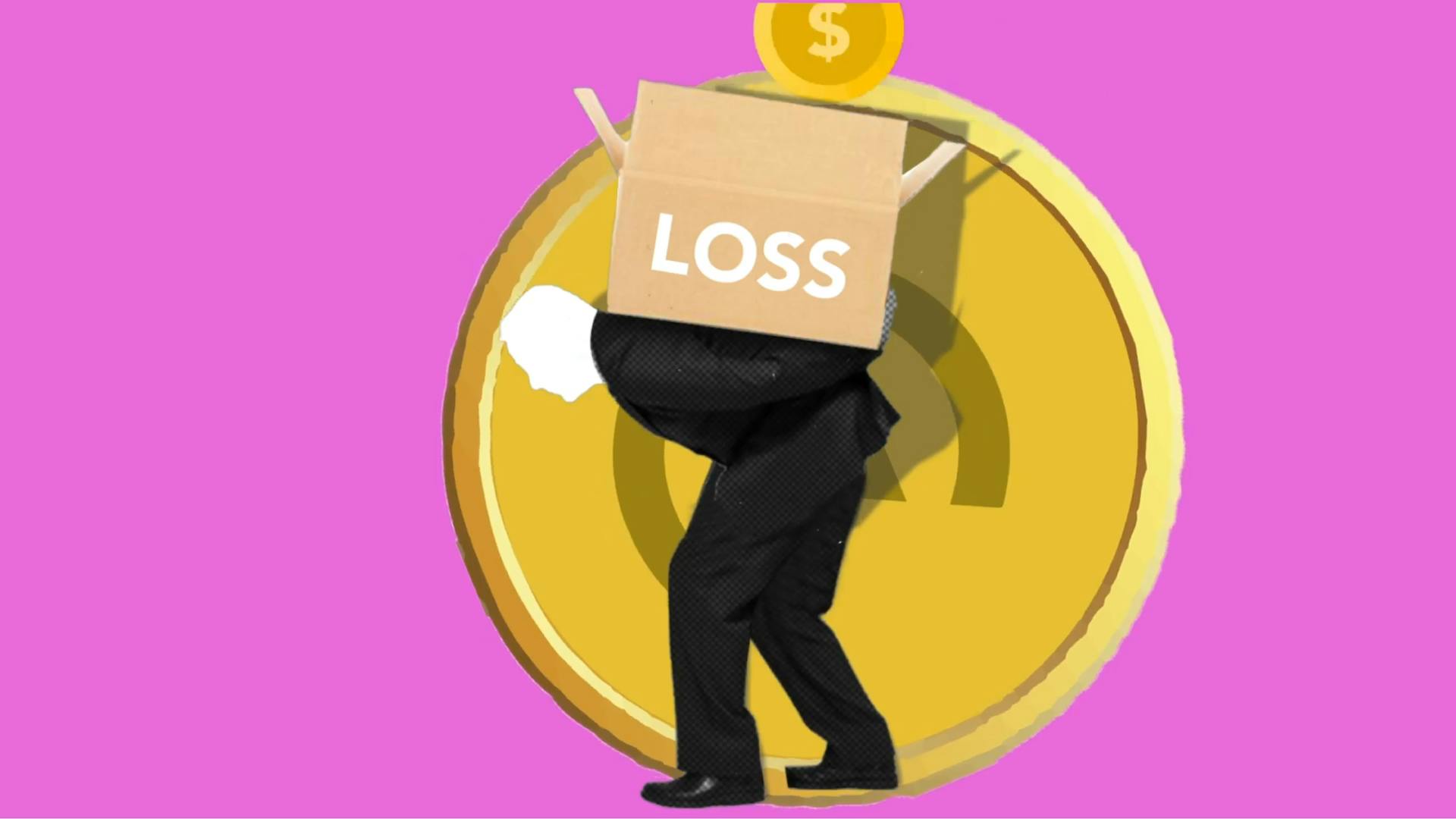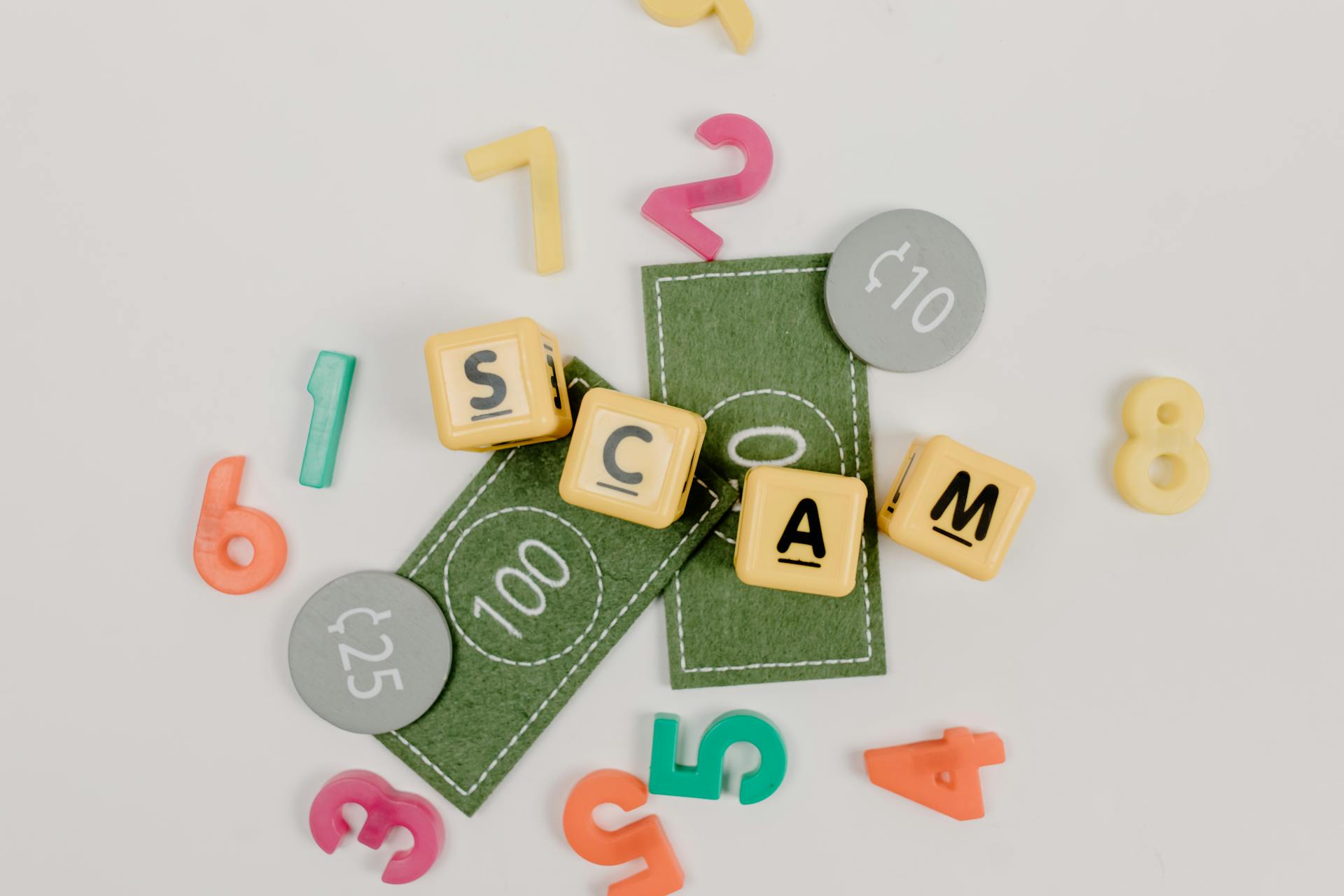
Debasement is a deliberate reduction in the value or purity of a currency, often to finance government spending or pay off debts.
This can be done through various methods, such as reducing the weight or metal content of coins, or increasing the number of units in circulation.
Debasement can have severe consequences, including inflation, economic instability, and loss of trust in the currency.
It's essential to understand the history of debasement to appreciate its impact on economies and societies.
What Is Debasement
Debasement is a process where the value of a currency or commodity is intentionally reduced by adding more of it into circulation. This can be done by increasing the money supply, causing the value of each unit to decrease.
It's a way for governments or institutions to pay off debts without actually having to pay the full amount. By debasing their currency, they can essentially print more money to cover their expenses.
Broaden your view: Did China Manipulate Currency to Pay for Us Tariffs
The value of a currency can be reduced by increasing the money supply, causing inflation, which erodes the purchasing power of consumers. This can be seen in the example of the Roman Empire, where the constant debasement of their currency led to a significant decline in its value.
Debasement can have severe consequences, including economic instability and a loss of trust in the currency.
History of Debasement
The French may have laid 20 French crowns to one, but the English would clip them, and the King himself would join in. This practice of debasement is nothing new.
The Romans, for instance, clipped their metal coins, a process most prevalent during Nero's reign. This allowed them to reissue eleven coins from the same amount of metal, increasing wealth by 10% – a scam that's still used today.
The Romans also decreased the silver content of their coins, from nearly pure silver to just 2% by the second half of the third century. This gradual erosion of monetary value was a symptom of deeper systemic problems.
The Weimar Republic of the 1920s is another example of the perils of monetary expansion. The German government printed more money, reducing the mark's value from around eight marks per dollar to 184, eventually collapsing in a painful hyperinflation when it reached 4.2 trillion marks per USD.
A different take: 2 Million Krw
The Roman Empire

The Roman Empire was a masterclass in debasement, folks. They started by clipping their metal coins, a practice most prevalent during the reign of Nero. The Romans would call in ten coins, then reissue eleven, fashioned out of the same amount of metal.
This process led to a gradual decrease in the value of the denarius, from nearly pure silver weighing 4.5 grams to only about 2% silver by the second half of the third century. The denarius continued to shrink in size and purity, until it was eventually replaced by the Argenteus.
The Ottoman Empire
The Ottoman Empire was a masterclass in debasement.
In the 15th century, the Ottoman Empire's official monetary unit, the akçe, contained a respectable 0.85 grams of silver.
The akçe went through consistent debasement over the centuries, with its intrinsic value decreasing dramatically.
By the 19th century, the akçe had dwindled to just 0.048 grams of silver.
Here's a breakdown of the akçe's weight in grams of silver and its corresponding index over the centuries:
The Ottoman Empire's debasement of the akçe was a deliberate measure to increase the money supply and make more coins.
Weimar Republic
The Weimar Republic is a stark reminder of the dangers of monetary expansion.
In the 1920s, the German government printed more money to meet its financial obligations, which reduced the mark's value from around eight marks per dollar to 184.
This measure led to a rapid depreciation of the mark, eventually collapsing in a painful hyperinflation by 1922, when it reached 7,350 marks per USD.
The mark continued to lose value, eventually reaching 4.2 trillion marks per USD, a staggering collapse of its original value.
The Weimar Republic's experience serves as a cautionary tale for the modern fiat system, highlighting the risks of gradual monetary debasement.
Recommended read: Hamburg Mark
Methods of Debasement
An administrative method to debase currency is for the mint to start issuing coins with less metal content than previous issues.
This method involves bringing old coins to the mint for re-minting, which can be incentivized by the promise of re-minting them into newer, more valuable coins.
If this caught your attention, see: Are Franklin Mint Coins Worth Anything

A revenue called seigniorage is made on this minting process, making it a profitable endeavor for the mint.
Clipping, sweating, and plugging were common types of debasement processes used until the introduction of paper money.
Sweating involves shaking coins vigorously in a bag until the edges come off and can be collected to make new coins.
Clipping involves shaving the edges of coins to remove metal, which can then be collected and used to make new counterfeit coins.
Plugging involves punching a hole out of the coin's middle area and hammering the rest together to close the gap, or sawing the coin in half and filling the hole with cheaper metal.
A unique perspective: What Currency Is Used in Prague Czech Republic
Effects of Debasement
Debasement can have far-reaching effects on an economy, and it's essential to understand these consequences. One of the most immediate effects of debasement is higher inflation rates. As the currency's value decreases, it takes more units to purchase the same goods and services, eroding the purchasing power of money.
A fresh viewpoint: 1943-s Steel Penny Value 2020
Central banks may respond to currency debasement and rising inflation by increasing interest rates. This can impact borrowing costs, business investments, and consumer spending patterns. Rising interest rates can make borrowing more expensive, which can slow down economic growth.
Currency debasement can also deteriorate the value of savings held in the domestic currency. This is particularly detrimental to individuals with fixed-income assets, such as retirees who rely on pensions or interest income. Their savings may not keep pace with inflation, reducing their purchasing power.
A debased currency can make imports more expensive, potentially leading to higher costs for businesses and consumers reliant on foreign goods. However, it may also make exports more competitive internationally, as foreign buyers can purchase domestic goods at a lower price.
Continuous currency debasement can undermine public confidence in the domestic currency and the government's ability to manage the economy effectively. This loss of trust may further exacerbate economic instability and even hyperinflation.
Here are some key effects of debasement:
- Higher inflation rates
- Increased interest rates
- Deterioration of savings value
- More expensive imports
- Loss of public confidence in the currency and government
Government and Debasement
The government's role in debasement is a crucial aspect to consider. The government can cause debasement by printing too much money, which increases the money supply and reduces the value of each unit.
Inflation is a direct result of debasement, and it can have a significant impact on the economy. Inflation erodes the purchasing power of money, making it more difficult for people to afford basic necessities.
Monetary policies can either exacerbate or mitigate debasement. Central banks can choose to print more money, which can lead to inflation, or they can implement policies that reduce the money supply.
You might enjoy: Inflation Index Etf
Henry VIII
Henry VIII was a key figure in the debasement of English coins. He needed more money to fund his military expenses during the European war.
His chancellor started to debase the coins by mixing cheaper metals like copper into the mix. This allowed them to make more coins at a lower cost.
The silver content of the coins decreased significantly under Henry VIII's reign. It went from 92.5% to only 25% by the end of his rule.
This drastic reduction in silver content had a lasting impact on the value of English currency.
Government Benefits
Debasement was commonly done when countries mixed low-quality metals with precious metals used to mint their coins. This practice allowed governments to create more coins than they had precious metals for, freeing up money for other purposes.
By debasing their currency, governments can use the freed-up money to pay off debts, fund new projects, and even finance wars. For instance, the United States Mint notes that coins were often made with a mix of metals, reducing their value.
Debasement also allows governments to print more money, which can be used to stimulate economic growth or finance large-scale projects. However, this can lead to inflation and a decrease in the currency's value over time.
Here are some benefits of debasement for governments:
- Frees up money for spending and paying off debts
- Allows governments to print more money and stimulate economic growth
- Can be used to finance wars and large-scale projects
Modern Era of Debasement
The modern era of debasement has brought about significant changes in the US monetary policy and money supply. The monetary base has surged to 5.6 trillion dollars by 2023.
This represents a 69-fold growth from its level of 81.2 billion dollars in 1971.
Understanding Debasement
Debasement is a process that has been around for centuries, and it's still relevant today. Currency debasement refers to lowering the value of a currency.
Traditionally, debasement involved mixing base metals into a currency made with precious metals, such as gold and silver. This practice allowed authorities to create more coins with the same face value, expanding the money supply at a lower cost.
This process of debasement can also happen if a government increases its money supply without a corresponding increase in output, leading to inflation. The value of the currency decreases, and the money becomes worth less.
In modern times, debasement can occur even if a currency is not made with precious metals. If a government prints too much money, it can lead to inflation and a decrease in the value of the currency.
A unique perspective: The Fed Can Change the Money Supply by Changing
Economic Savior or Silent Thief?
Debasement can be a double-edged sword for economies. Currency debasement refers to lowering the value of a currency.
This can happen in a few ways, but one traditional method involves mixing base metals into a currency made with precious metals, thus lowering the currency's value. This process can also occur when a government increases its money supply without a corresponding increase in output.
The result of debasement is inflation for citizens, which can be a heavy burden to bear. Currency debasement gives more money to governments for spending, but it comes at the cost of decreased purchasing power for individuals.
Here are some key facts about debasement:
- Currency debasement refers to lowering the value of a currency.
- Currency debasement can happen when a government increases its money supply without a corresponding increase in output.
- Currency debasement gives more money to governments for spending, but it results in inflation for citizens.
Understanding
Currency debasement is a process that has been around for centuries, and it's still relevant today. It's a way for governments to create more money without having to use precious metals like gold and silver.
In the past, coins were made with precious metals, but they were often mixed with lower-value metals to save on costs. This practice is still referred to as debasement.
Coins made from precious metals are still used today, but they're not as common as they once were. Gold and silver bullion are still traded and owned, but they're not used as everyday currency.
Most currencies today are fiat currencies, which means they're not based on a precious metal. This makes it easier for governments to print more money, which can lead to debasement.
Debasement can occur when a government prints too much money, increasing the money supply without a corresponding increase in output. This can lead to inflation, as the money becomes less valuable.
Here are some key points to keep in mind about debasement:
- Currency debasement refers to lowering the value of a currency.
- Currency debasement is traditionally associated with mixing base metals into a currency made with precious metals.
- This process of debasement can also happen if a government increases its money supply without a corresponding increase in output.
- Currency debasement gives more money to governments for spending even though it results in inflation for citizens.
Why Debasement Happens
Governments debase their currency to spend without raising further taxes, often to fund wars. This approach increases the money supply, but it's a short-sighted benefit that leads to inflation and financial crises.
Debasement is an effective way to engage in expensive conflicts without affecting people's finances, or so it is believed. It's a way for governments to get what they want without making tough decisions.
In the long term, money supply increases lead to inflation, which affects those who don't own hard assets. Inflation is like "legal counterfeiting", as Robert Breedlove puts it.
Governments can take measures to mitigate risks associated with money debasement, such as controlling the money supply and interest rates.
Worth a look: A Decrease in the Reserve Ratio Increases the
Real-World Examples
The Roman Empire is a great example of debasement in action. Emperor Nero reduced the silver content in Roman coins from 100% to 90% around 60 AD.
This was the first recorded example of currency debasement, setting a precedent for future emperors. Nero's decision was likely driven by the need to fund his lavish spending.
The silver content continued to decrease over the next 150 years, eventually reaching 0.5% by 265 AD. This drastic reduction in value led to severe financial crises and inflation.
Emperor Domitian briefly reversed this trend by increasing the silver content to 98%, but ultimately had to revert to debasement when another war broke out. This cycle of debasement and inflation continued throughout the Roman Empire.
In the early 1920s, the German government printed money to meet its financial obligations, reducing the value of the mark from around eight per U.S. dollar to 184 per U.S. dollar. This move ultimately led to the collapse of the currency.
Consider reading: Financial Rand
Solution
The solution to debasement lies in the reintroduction of sound money, and Bitcoin offers a permanent solution to this issue.
Its supply is capped at 21 million, a number that is hard-coded and safeguarded by proof-of-work mining and a decentralized network of nodes.
This makes it resilient to the inflationary pressures that are typically seen with traditional fiat currencies.
No single entity or government can control Bitcoin's issuance or governance, thanks to its decentralized nature.
This inherent scarcity makes Bitcoin a store-of-value asset, and people are starting to recognize it as the next evolution of money.
Explore further: Bitcoin Economics
Frequently Asked Questions
What is another word for debasement?
Alternative words for debasement include corrupt, deprave, and vitiate, which all convey a sense of moral or ethical decline. These synonyms can be used in place of debasement in various contexts.
Sources
- https://en.wikipedia.org/wiki/Debasement
- https://www.investopedia.com/terms/d/debasement.asp
- https://www.vantagepointsoftware.com/blog/currency-debasement-economic-savior-or-silent-thief/
- https://www.businessinsider.com/the-long-and-sordid-history-of-currency-debasement-2012-6
- https://bitcoinmagazine.com/glossary/debasement
Featured Images: pexels.com


